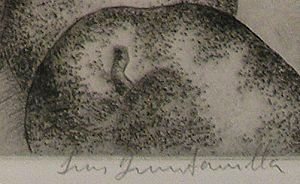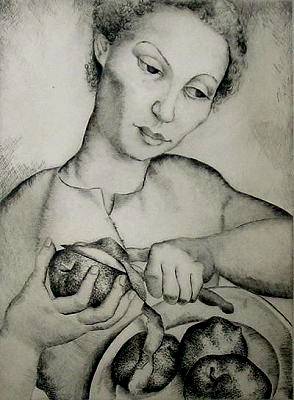|
Table of Contents
To navigate this catalogue raisonné, choose from the links below. |
|
Thumbnails, Part 4:
Prints made for Illustrated Books (These prints are not included in the catalogue raisonné proper.) |
|
A Biographical Chronology
of the artist (and its accompanying linked pages) appears on the website The Art and World of Luis Quintanilla |
|
To navigate
The Fiene Quintanilla Online Catalogue Raisonné Project, use the links below. |
| Useful Links |
| Quintanilla Copyright ©2006, Jeffrey Coven, CATRAIS Copyright ©2010 IA\TPC |
A Catalogue Raisonné
(in progress)
Title: Paulette*
Series: New York Prints
Date: 1939**
Medium: Intaglio***
Edition: 147****
Dimensions: 13 7/16 x 9 5/8 in. (34.1 x 24.5 cm)
Printer and Publisher: Printer currently unknown; publisher, Associated American Artists (AAA)
Paper: laid with "Georgian" watermark
Signature: typically signed in pencil, l.r., partially over the plate mark*****
Public collections holding this print: BMA; SDMA; SFFAM (Achenbach Foundation for Graphic Arts); WMAA
Topic galleries for this print:
1. Quintanilla prints published by Associated American Artists
2. Women (studies of)
*Title: Typically AAA prints were signed in pencil but without further pencil annotation; Paulette is the title as it appeared on the AAA label.
**Date: At least one impression was printed, signed and dated in 1939, as it is signed and dated in the artist's hand, l.l., "1939"; however, 1940 is the date this print was published by Associated American Artists. (See "Edition" below.)
***Medium: Although Quintanilla's most commonly employed intaglio printmaking technique was drypoint, which was the sole technique he used in Spain, Associated American Artists, the publisher of this print, calls Paulette an etching. No final determination about the technique or combination of techniques used in this print has yet been arrived at by us.
****Edition: The number "147" is taken from Associated American Artists (AAA) records (Windisch). Typically (but with some exceptions as here), AAA editions were 250 impressions. It is not known how many impressions may have been printed in 1939, and if they are included in the 147 listed by AAA.
*****Signature: (See below.)

Although the identity of Paulette is not currently known, two sketches using the wife of the artist as model could have been studies for the etching. Note in both cases below the image is the reverse of the image in the etching.
 |
 |
|
pencil on paper 11 3/4 x 9 in.
|
pencil on paper, 7 x 10 in.
|
Women and fruit or vegetables in the same composition, a combination of portraiture and still life, appear in several works throughout the 1940's and 1950's. (See below.)

Juanita, oil on canvas, c. 1957
